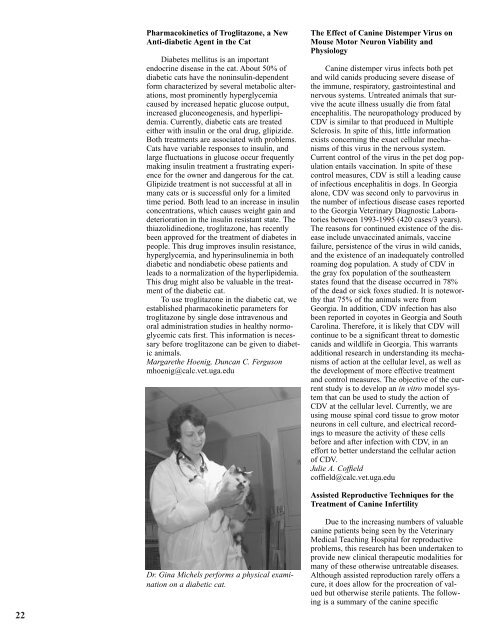M E S '9 8 - University of Georgia College of Veterinary Medicine
M E S '9 8 - University of Georgia College of Veterinary Medicine
M E S '9 8 - University of Georgia College of Veterinary Medicine
- No tags were found...
Create successful ePaper yourself
Turn your PDF publications into a flip-book with our unique Google optimized e-Paper software.
Pharmacokinetics <strong>of</strong> Troglitazone, a NewAnti-diabetic Agent in the CatDiabetes mellitus is an importantendocrine disease in the cat. About 50% <strong>of</strong>diabetic cats have the noninsulin-dependentform characterized by several metabolic alterations,most prominently hyperglycemiacaused by increased hepatic glucose output,increased gluconeogenesis, and hyperlipidemia.Currently, diabetic cats are treatedeither with insulin or the oral drug, glipizide.Both treatments are associated with problems.Cats have variable responses to insulin, andlarge fluctuations in glucose occur frequentlymaking insulin treatment a frustrating experiencefor the owner and dangerous for the cat.Glipizide treatment is not successful at all inmany cats or is successful only for a limitedtime period. Both lead to an increase in insulinconcentrations, which causes weight gain anddeterioration in the insulin resistant state. Thethiazolidinedione, troglitazone, has recentlybeen approved for the treatment <strong>of</strong> diabetes inpeople. This drug improves insulin resistance,hyperglycemia, and hyperinsulinemia in bothdiabetic and nondiabetic obese patients andleads to a normalization <strong>of</strong> the hyperlipidemia.This drug might also be valuable in the treatment<strong>of</strong> the diabetic cat.To use troglitazone in the diabetic cat, weestablished pharmacokinetic parameters fortroglitazone by single dose intravenous andoral administration studies in healthy normoglycemiccats first. This information is necessarybefore troglitazone can be given to diabeticanimals.Margarethe Hoenig, Duncan C. Fergusonmhoenig@calc.vet.uga.eduThe Effect <strong>of</strong> Canine Distemper Virus onMouse Motor Neuron Viability andPhysiologyCanine distemper virus infects both petand wild canids producing severe disease <strong>of</strong>the immune, respiratory, gastrointestinal andnervous systems. Untreated animals that survivethe acute illness usually die from fatalencephalitis. The neuropathology produced byCDV is similar to that produced in MultipleSclerosis. In spite <strong>of</strong> this, little informationexists concerning the exact cellular mechanisms<strong>of</strong> this virus in the nervous system.Current control <strong>of</strong> the virus in the pet dog populationentails vaccination. In spite <strong>of</strong> thesecontrol measures, CDV is still a leading cause<strong>of</strong> infectious encephalitis in dogs. In <strong>Georgia</strong>alone, CDV was second only to parvovirus inthe number <strong>of</strong> infectious disease cases reportedto the <strong>Georgia</strong> <strong>Veterinary</strong> Diagnostic Laboratoriesbetween 1993-1995 (420 cases/3 years).The reasons for continued existence <strong>of</strong> the diseaseinclude unvaccinated animals, vaccinefailure, persistence <strong>of</strong> the virus in wild canids,and the existence <strong>of</strong> an inadequately controlledroaming dog population. A study <strong>of</strong> CDV inthe gray fox population <strong>of</strong> the southeasternstates found that the disease occurred in 78%<strong>of</strong> the dead or sick foxes studied. It is noteworthythat 75% <strong>of</strong> the animals were from<strong>Georgia</strong>. In addition, CDV infection has alsobeen reported in coyotes in <strong>Georgia</strong> and SouthCarolina. Therefore, it is likely that CDV willcontinue to be a significant threat to domesticcanids and wildlife in <strong>Georgia</strong>. This warrantsadditional research in understanding its mechanisms<strong>of</strong> action at the cellular level, as well asthe development <strong>of</strong> more effective treatmentand control measures. The objective <strong>of</strong> the currentstudy is to develop an in vitro model systemthat can be used to study the action <strong>of</strong>CDV at the cellular level. Currently, we areusing mouse spinal cord tissue to grow motorneurons in cell culture, and electrical recordingsto measure the activity <strong>of</strong> these cellsbefore and after infection with CDV, in aneffort to better understand the cellular action<strong>of</strong> CDV.Julie A. C<strong>of</strong>fieldc<strong>of</strong>field@calc.vet.uga.edu22Dr. Gina Michels performs a physical examinationon a diabetic cat.Assisted Reproductive Techniques for theTreatment <strong>of</strong> Canine InfertilityDue to the increasing numbers <strong>of</strong> valuablecanine patients being seen by the <strong>Veterinary</strong>Medical Teaching Hospital for reproductiveproblems, this research has been undertaken toprovide new clinical therapeutic modalities formany <strong>of</strong> these otherwise untreatable diseases.Although assisted reproduction rarely <strong>of</strong>fers acure, it does allow for the procreation <strong>of</strong> valuedbut otherwise sterile patients. The followingis a summary <strong>of</strong> the canine specific

















